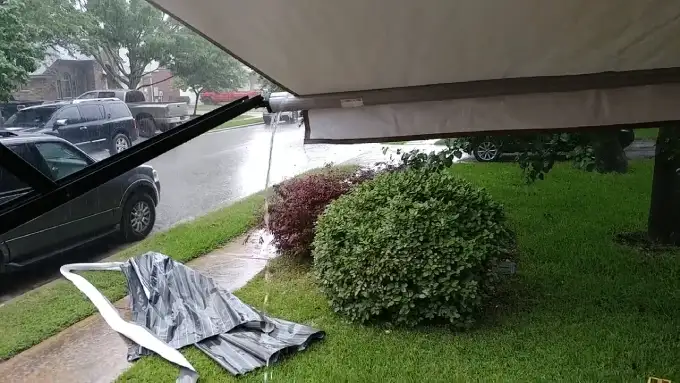Last Updated on April 11, 2023
It is highly discouraged despite the desire to leave your RV awning out in inclement weather. Rainfall can be devastating for such structures as water pooling, mildew and mold growth, fabric degeneration and wear, which negatively affect an unprotected awning’s integrity, leaving you with costly repairs or replacement.
Before leaving your RV’s awning out in the rain, it is important to consider those potential risks. This blog post dives into those possibilities so you can decide what’s best for protecting and preserving your beloved recreational vehicle.
Can You Leave RV Awning Out In Rain: Potential Problems
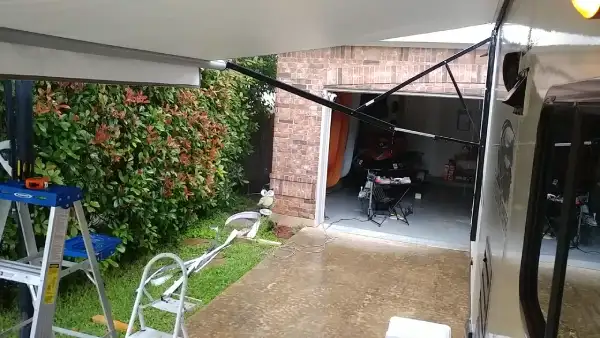
When you’re on an extended journey, letting your RV awning sit out in the rain might be tempting for convenience. Unfortunately, that can come with dangerous side effects, from weakened fabrics and support structures to even putting travelers at risk of injury.
You may encounter the following issues:
Water Pooling and Weight Load
If you leave your RV awning out in the rain, one of the potential problems you may encounter is water pooling and weight load. Water pooling occurs when rainwater accumulates on top of the awning fabric due to insufficient pitch or angle. This can cause sagging and stretching of the fabric, leading to damage and even tearing.
Moreover, when there is too much water accumulation on your RV awning, it can put extra weight on the structure. The excess weight can cause significant stress on the awning arms and brackets, which can lead to bending or breaking.
Retracting your RV awning before a heavy storm hits is best to avoid these issues. However, if you cannot do so, ensure that your awning has enough pitch or slope to allow rainwater to run off quickly. You can adjust the pitch by lowering one end of the awning slightly using adjustable legs or poles.
Mildew and Mold Growth
An RV awning that is left out in the rain can lead to a number of problems, including mildew and mold growth. These fungi thrive in damp environments and can quickly take hold of the fabric of your awning if it is left wet for an extended period of time.
Mildew and mold look unsightly and can cause health problems, particularly for those with allergies or respiratory issues. In addition, they can weaken the fabric of your awning, making it more prone to tears and other damage.
To prevent mildew and mold growth on your RV awning, keeping it as dry as possible is important. This means retracting your awning before a storm hits or if you know that rain is forecasted. When it rains, check and remove any accumulated standing water on your awning if you can’t retract it.
Fabric Damage and Wear and Tear
Rain can cause RV awnings to suffer fabric damage and wear and tear over time. The constant exposure to moisture can cause the fabric to weaken, fade, and even tear. The longer the awning is left out in the rain, the greater the risk of damage.
A few factors can contribute to fabric damage on an RV awning. One of them is UV exposure, which can cause the fabric to become brittle and crack over time. Another factor is wind, which can cause the fabric to flap around and rub against itself, leading to tears and holes.
To prevent fabric damage on your RV awning, it’s important to take proper care of it. Regular cleaning is essential to remove dirt and debris that can cause premature wear on the fabric. You should also avoid using harsh chemicals or abrasive cleaners that could damage the material.
Steps to Protect Your RV Awning from the Rain
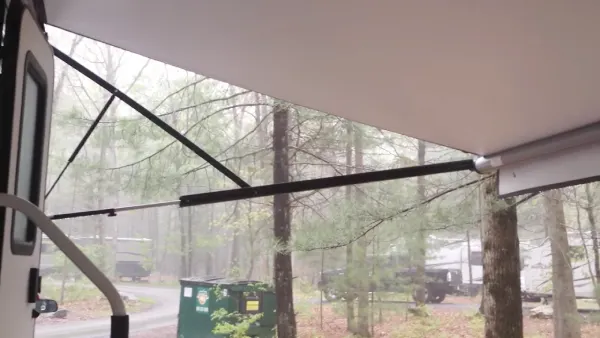
RV awnings are a great addition to any camping trip, providing shade and protection from the sun. However, when it comes to rain, your awning can quickly become a liability if not properly protected.
To keep your RV awning dry, here are some tips:
ONE: Install an Awning Protector
An awning protector is a great investment for any RV owner who wants to keep their awning safe from the elements. These protectors are designed to shield your awning from heavy rain, hailstorms, and snow loads that can cause water damage and tears in the fabric.
When selecting an awning protector, choosing one that fits your specific type of RV awning is important. Some popular options include aluminum or polycarbonate covers that attach directly to the RV or retractable covers made of durable fabric.
By installing an awning protector, you can ensure that your awning is angled correctly. This means that rainwater will run off the sides of the awning rather than pooling in the center and causing damage. A properly angled awning can also provide better shade and protection from other weather elements like wind and sun.
In addition to providing extra protection, an awning protector can also help tighten up the fabric on your RV awning. Over time, exposure to rain and other elements can cause the fabric to stretch out and become loose. This looks unsightly and can make your awning less effective at keeping you dry during a sudden rainstorm.
TWO: Angle the Awning Correctly
When setting up your RV awning, it’s important to angle it correctly to protect it from rain damage. Angling the awning is crucial because if you don’t, water can pool on the fabric and cause stretching or even tearing.
So, how do you angle your RV awning correctly? It’s actually quite simple. First, ensure that one end of the awning is lower than the other. This will allow rainwater to run off instead of collecting in one spot.
You can also use adjustable legs or poles to angle the awning further and create a slope for water runoff. These accessories can be purchased at most RV supply stores or online.
Another tip is to position your RV so that the awning faces away from prevailing winds. This will help with angling and prevent wind-driven rain from hitting the underside of the awning.
THREE: Tighten Up the Fabric
Tightening up the fabric of your RV awning is an essential step in protecting it from rain damage. When the fabric is loose, it can catch water, causing it to pool and eventually damage the material. Here are some steps to tighten up your RV awning’s fabric:
Adjust the Tension: Most RV awnings come with adjustable tension settings that allow you to tighten or loosen the fabric as needed. You can adjust the tension by turning a knob or using a crank handle.
Use Rafter Supports: Installing rafter supports under your awning can help prevent sagging and keep the fabric taut. These supports are easy to install and can be adjusted to fit your specific needs.
Replace Worn-out Springs: The springs on your RV awning play a crucial role in keeping the fabric tight and preventing water buildup. If you notice that your awning’s fabric is loose, check the springs for signs of wear and tear. Replacing worn-out springs can help restore tension to your awning.
Consider Adding Wind Sensors: Wind sensors are a great addition to any RV awning system as they automatically retract the awning during high winds, preventing damage caused by heavy rain or hailstorms.
FOUR: Use Chemicals for Waterproofing
Waterproofing your RV awning is important in protecting it from rain and other weather elements. Chemicals for waterproofing can help prevent water damage to your awning, which can be costly to repair or replace.
One of the most popular chemicals used for waterproofing is silicone spray. This spray type is easy to apply and can provide long-lasting protection against water damage. To use silicone spray on your awning, make sure the fabric is clean and dry before applying.
Spray the silicone evenly over the entire awning surface, covering all seams and edges.
Another option for waterproofing your RV awning is a seam sealer. Seam sealers are designed to fill in any gaps or holes in the fabric, preventing water from seeping through. To use a seam sealer, simply apply it along any seams or edges vulnerable to water damage.
It’s important to note that while chemical waterproofing can be effective, it’s not a substitute for proper maintenance and care of your RV awning. Regular cleaning and inspection can help prevent water damage before it occurs.
If you do notice any leaks or tears in your awning fabric, it’s best to address them immediately before they worsen.
Is It Okay to Use An Rv Awning During Light Rain?
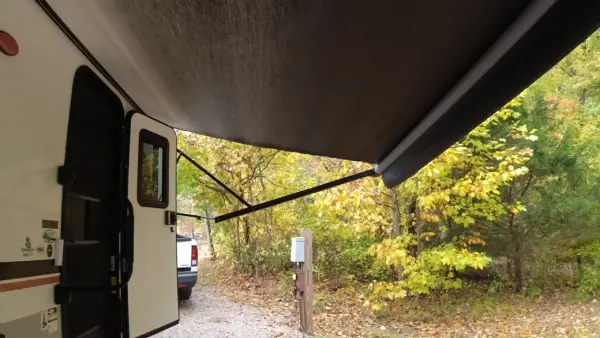
An RV awning is a perfect way to enjoy some fresh air in light rain. Make sure you’ve set it up properly. These clever contraptions provide both shade and protection from mild, wet weather, but their design won’t shield against heavy downpours.
Protect yourself and maximize the benefits of your RV awning with careful installation and regular maintenance checks. Be sure all bolts, screws, and other hardware are securely fastened before setting off on any adventure, then check them again after returning home to ensure everything is still in place.
Likewise, if any part of your awning appears loose or unsteady due to wind or other conditions, adjust or secure it properly before using it in rainy weather.
What Is the Maximum Amount of Wind That An Awning Can Handle?
An awning’s wind resistance is determined by the Beaufort scale, which measures wind speed in kilometers per hour (km/h). The maximum amount of wind an awning can handle depends on the type of awning being used.
For standard awnings, the maximum wind resistance is up to 5 Beaufort scale, which translates to winds between 29-38 km/h. The maximum wind they can handle for higher-end retractable awnings is above 6 Beaufort scales, meaning winds between 39-49 km/h.
Although these are the general limits for awnings, they can still be damaged by extreme weather conditions like heavy rain or hail and should only be used cautiously when there are strong winds.
Wet Weather Arrives: Keep Your Awning Off
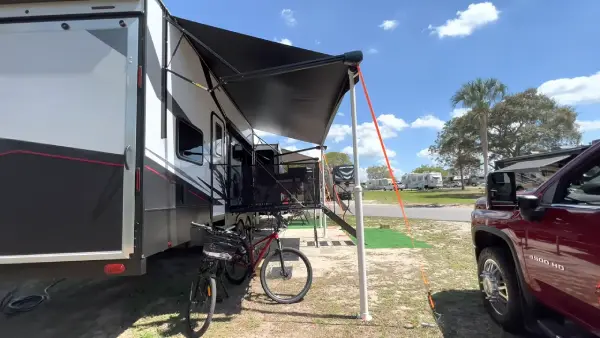
Owning an RV means you need to properly care for your awning properly – even if rain may seem like a tempting invitation. Don’t be tempted unless the fabric is waterproof and all its mountings are secure, as protecting it from moisture will ensure that this key part of your vacation vehicle lasts for many road trips ahead.
Regular upkeep is essential to ensure your awning and RV remain in optimal condition. Although, even with this effort to prevent damage, risks can still arise, from mold or mildew growth to unequal water distribution and weight loads.
Be sure to check up on the setup regularly so you’re always aware of any potential dangers. If you notice any problems or issues with your awning system, contact a professional for help immediately.

